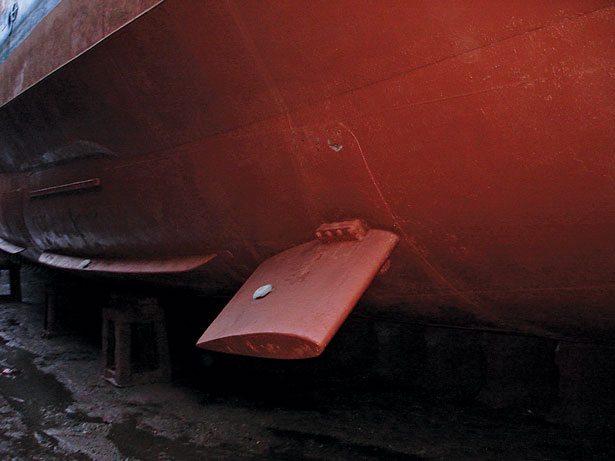The first motoryacht I served aboard as captain was the penultimate build for John Trumpy & Sons. Its 72-foot double-planked mahogany on oak framed hull had the latest in early 1970s technology, including stabilizers.

A Cessna aircraft gyroscope linked with a Ford truck hydraulic brake pump running from a power-takeoff on the port engine operated that Trumpy houseboat’s stabilizer fins. Stabilizer technology has had major upgrades in the ensuing 40 plus years, but many of those early concepts remain the same.
Stabilizers were initially designed to minimize rolling underway in beam seas aboard power driven vessels. They function the same way pectoral fins do on dolphins. As dolphins play along a yacht’s bow wave, they can roll to the left or right by moving their pectoral fins up or down. Stabilizer fins aboard yachts protrude from the hull at an angle similar to the dolphin’s pectoral fins, and rotate to provide lift through the water to counteract roll. The gyroscope provides a horizontal frame of reference for the stabilizer system in the same manner that a gyro provides an artificial horizon aboard an aircraft.
New Seakeeper Ride Eliminates Up to 70% of Underway Pitch and Roll
Leading manufacturers, such as Quantum and Naiad, have refined the gyro-fin type of stabilizer system to operate both underway and at anchor. According to Naiad, “All vessels have their own roll period depending on hull shape and loading. Wave motions initiate this roll and, if in close synchronization with the hull’s natural roll period, roll may build to uncomfortable or even dangerous proportions. The principle behind Naiad fin stabilization is to counteract the tendency of a vessel to roll with an equivalent and opposite righting moment applied in exactly the proper phase and proportion.”

Quantum pioneered the technology for its trademarked Zero Speed stabilizing system for megayachts and superyachts. Whether at anchor or just drifting in calm water with a light swell, the Zero Speed system actively engages the port and starboard fins to move in large sweeping motions. This can dampen the roll significantly. For example, reducing roll from fourteen degrees to four degrees. The result is a much more comfortable motion for both guests and crew on board. Quantum took one further step to increase roll-damping capabilities at anchor by offering a unique system using retractable rotating cylinders instead of fins. These spinning cylinders rely on a concept first described by a German scientist named Magnus in 1852. He observed that a spinning ball or rotating cylinder in fluid creates lift. A skilled baseball pitcher, using this Magnus effect, can throw pitches with top spin, back spin and side spin that can’t be hit due to the unexpected trajectory created by lift on the way to home plate. Taking advantage of the Magnus effect in stabilization, a dramatic twenty two-degree roll can be reduced to a much tamer roll of one and a half degrees.
Although Naiad and Quantum use small gyroscopes integrated into control systems that monitor motion sensors, the angle of waves, plus the velocity and acceleration of the vessel to regulate fin response, there is another method of stabilization on the market. It was first developed in 1917, and recently brought into the 21st century by Seakeeper for use aboard yachts.

Seakeeper uses the gyroscope itself to stabilize yachts up to 100 gross tons. Instead of providing a reference plane for fin actuation, the Seakeeper gyroscope uses a basic rule of physics for stabilization. Remember the classic childhood educational toy the spinning gyroscope? It seemed to defy gravity as it sought to remain vertical no matter how much one tilted the string or pencil tip it balanced upon. This gyroscopic phenomenon, where the spinning axis slowly rotates around the vertical, is called precession. It is caused by the angular momentum of the spinning rotor following its torque.
The Seakeeper stabilizer system uses this same torque to eliminate up to 95 per cent of the roll on a yacht, depending on boat speed and wave height. The Seakeeper flywheel is encased in gimbaled spherical metal housing, and spins in a vacuum at speeds up to 10,700rpm. “When the boat rolls, the gyro tilts fore and aft, producing a powerful gyroscopic torque to port and starboard that counteracts the boat roll,” states Seakeeper’s marketing brochure.
In order for the Seakeeper’s torque control to function properly, the gyroscope unit is affixed to the hull structure along the boat’s centerline. And by locating it aft of amidships, it optimizes stabilization at high speeds or in large waves. Seakeeper, co-founded by marine innovator Shepard McKenney, now markets gyroscopic stabilization systems for powerboats as small as 30ft LOA.
Whether operating a twin outboard deep-V center console or a superyacht, the benefits of roll control are now available to recreational fishermen as well as guests sipping cocktails al fresco on the sundeck.
Capt. Jeff Werner has been part of the yachting industry for over 25 years. In addition to working as a captain on private and charter yachts, both sail and power, he is a certified instructor for the RYA, MCA, USCG and US Sailing. He also owns Diesel Doctor (MyDieselDoctor.com).





